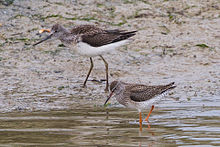Tringa
| Tringa | |
|---|---|

| |
| Common greenshank (Tringa nebularia) and common redshank (Tringa totanus) at Cuckmere Haven, Sussex, England | |
| Scientific classification | |
| Domain: | Eukaryota |
| Kingdom: | Animalia |
| Phylum: | Chordata |
| Class: | Aves |
| Order: | Charadriiformes |
| Family: | Scolopacidae |
| Genus: | Tringa Linnaeus, 1758 |
| Type species | |
| Tringa ochropus (green sandpiper) Linnaeus, 1758
| |
| Species | |
|
13, see text | |
| Synonyms | |
| |
Tringa is a genus of waders, containing the shanks and tattlers. The genus name Tringa is the Neo-Latin name given to the green sandpiper by the Italian naturalist Ulisse Aldrovandi in 1599. They are mainly freshwater birds, often with brightly coloured legs as reflected in the English names of six species, as well as the specific names of two of these and the green sandpiper. They are typically associated with northern hemisphere temperate regions for breeding. Some of this group—notably the green sandpiper—nest in trees, using the old nests of other birds, usually thrushes.
The
The present genus in the old, more limited sense was even further subdivided into Tringa proper and
Taxonomy
The genus Tringa was introduced in 1758 by the Swedish naturalist Carl Linnaeus in the tenth edition of his Systema Naturae.[3] The name Tringa is the Neo-Latin name given to the green sandpiper by the Italian naturalist Ulisse Aldrovandi in 1603 based on Ancient Greek trungas, a thrush-sized, white-rumped, tail-bobbing wading bird mentioned by Aristotle.[4][5] The type species is the green sandpiper (Tringa ochropus).[6]
Species
The genus contains 13 species.[7]
- Green sandpiper, Tringa ochropus
- Solitary sandpiper, Tringa solitaria
- Grey-tailed tattler, Tringa brevipes – formerly Heteroscelus brevipes
- Wandering tattler, Tringa incana – formerly Heteroscelus incanus
- Spotted redshank, Tringa erythropus
- Greater yellowlegs, Tringa melanoleuca
- Common greenshank, Tringa nebularia
- Willet, Tringa semipalmata – formerly Catoptrophorus semipalmatus
- Lesser yellowlegs, Tringa flavipes
- Nordmann's greenshank, Tringa guttifer
- Marsh sandpiper, Tringa stagnatilis
- Common redshank, Tringa totanus
- Wood sandpiper, Tringa glareola
-
Tringa legs are either red (Spotted redshank, T. erythropus), ...
-
... yellow (Lesser yellowlegs, T. flavipes), ...
-
... pale green (Common greenshank, T. nebularia), ...
-
... or ochre (Wood sandpiper, T. glareola)
Systematics and evolution

The shanks' and tattlers' closest relatives are
.The same study
The
Fossil record[9]
- ?Tringa edwardsi (Quercy Late Eocene/Early Oligocene of Mouillac, France)
- ?Tringa gracilis (Early Miocene of WC Europe) – calidrid?
- ?Tringa lartetianus (Early Miocene of Saint-Gérand-le-Puy, France)
- Tringa spp. (Early Miocene of Ravolzhausen, Germany – Early Pleistocene of Europe)[12]
- ?Tringa grivensis (Middle Miocene of Grive-Saint-Alban, France)
- ?Tringa majori (Middle Miocene of Grive-Saint-Alban, France)
- ?Tringa minor (Middle Miocene of Grive-Saint-Alban, France) – includes "Erolia" ennouchii; calidriid?
- ?Tringa grigorescui (Middle Miocene of Ciobăniţa, Romania)
- ?Tringa scarabellii (Late Miocene of Senigallia, Italy)
- Tringa sp. 1 (Late Miocene/Early Pliocene of Lee Creek Mine, USA)
- Tringa sp. 2 (Late Miocene/Early Pliocene of Lee Creek Mine, USA)
- ?Tringa numenioides (Early Pliocene of Odesa, Ukraine)
- Tringa antiqua (Late Pliocene of Meade County, USA)
- Tringa ameghini (Late Pleistocene of Talara Tar Seeps, Peru)
"Tringa" hoffmanni is now in Ludiortyx. While its relationships are disputed, it was not a charadriiform.
See also
References
- ^ Pereira & Baker (2005), Banks et al. (2006)
- ^ Ballmann (1969), Pereira & Baker (2005)
- ^ Linnaeus, Carl (1758). Systema Naturae per regna tria naturae, secundum classes, ordines, genera, species, cum characteribus, differentiis, synonymis, locis (in Latin). Vol. 1 (10th ed.). Holmiae (Stockholm): Laurentii Salvii. p. 148.
- ISBN 978-1-4081-2501-4.
- ^ Aldrovandi, Ulisse (1603). Vlyssis Aldrovandi philosophi ac medici Bononiensis historiam naturalem in gymnasio Bononiensi profitentis, Ornithologiae (in Latin). Vol. 3. Bononiae (Bologna, Italy): Franciscum de Franciscis Senensem. pp. 480–483, Lib. 20 Cap. 54.
- ^ Peters, James Lee, ed. (1934). Check-List of Birds of the World. Vol. 2. Cambridge, Massachusetts: Harvard University Press. p. 264.
- Rasmussen, Pamela, eds. (July 2021). "Sandpipers, snipes, coursers". IOC World Bird List Version 11.2. International Ornithologists' Union. Retrieved 17 August 2021.
- ^ a b van Tuinen et al. (2004)
- ^ a b Mlíkovský (2002)
- ^ Paton et al. (2003)
- ^ Pereira & Baker (2005)
- ^ Apparently at least three species at Stránská skála (Czech Republic, Early Pleistocene) for example: Mlíkovský (2002)
Sources
- Ballmann, Peter (1969): Les Oiseaux miocènes de la Grive-Saint-Alban (Isère) [The Miocene birds of Grive-Saint-Alban (Isère)].
- Banks, Richard C.; Cicero, Carla; Dunn, Jon L.; Kratter, Andrew W.; Rasmussen, Pamela C.; Remsen, J.V. Jr.; Rising, James D. & Stotz, Douglas F. (2006): Forty-seventh Supplement to the American Ornithologists' Union Check-list of North American Birds. DOI: 10.1642/0004-8038(2006)123[926:FSTTAO]2.0.CO;2
- Mlíkovský, Jirí (2002): Cenozoic Birds of the World, Part 1: Europe. Ninox Press, Prague. ISBN 80-901105-3-8
- Olson, Storrs L.(1985): Section X.D.2.b. Scolopacidae. In: Farner, D.S.; King, J.R. & Parkes, Kenneth C. (eds.): Avian Biology 8: 174–175. Academic Press, New York.
- Paton, Tara A.; Baker, Allan J.; Groth, J.G. & Barrowclough, G.F. (2003): "RAG-1 sequences resolve phylogenetic relationships within charadriiform birds." PMID 13678682
- Pereira, Sérgio Luiz & Baker, Alan J. (2005): Multiple Gene Evidence for Parallel Evolution and Retention of Ancestral Morphological States in the Shanks (Charadriiformes: Scolopacidae)[DOI: 10.1650/0010-5422(2005)107[0514:MGEFPE]2.0.CO;2
- van Tuinen, Marcel; Waterhouse, David & Dyke, Gareth J. (2004): Avian molecular systematics on the rebound: a fresh look at modern shorebird phylogenetic relationships.




